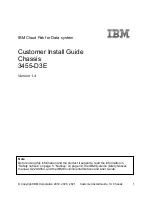
©
National Instruments Corporation
57
NI cDAQ-9172 User Guide and Specifications
Measurements Using Two Pulse Encoders
The counter supports two pulse encoders that have two channels—channels
A and B.
The counter increments on each rising edge of channel A. The counter
decrements on each rising edge of channel B, as shown in Figure 32.
Figure 32.
Measurements Using Two Pulse Encoders
For information on connecting counter signals, refer to the
section.
Two-Signal Edge-Separation Measurement
Two-signal edge-separation measurement is similar to pulse-width
measurement, except that there are two measurement signals—AUX and
Gate. An active edge on the AUX input starts the counting and an active
edge on the Gate input stops the counting. You must arm a counter to begin
a two edge separation measurement.
After the counter has been armed and an active edge occurs on the AUX
input, the counter counts the number of rising (or falling) edges on the
Source. The counter ignores additional edges on the AUX input.
The counter stops counting upon receiving an active edge on the Gate input.
The counter stores the count in a hardware save register.
You can configure the rising or falling edge of the AUX input or the Gate
input to be the active edge.
Use this type of measurement to count events or measure the time that
occurs between edges on two signals. This type of measurement is
sometimes referred to as start/stop trigger measurement, second gate
measurement, or A-to-B measurement.
Single Two-Signal Edge-Separation Measurement
With single two-signal edge-separation measurement, the counter counts
the number of rising (or falling) edges on the Source input occurring
between an active edge of the Gate signal and an active edge of the AUX
signal. The counter then stores the count in a hardware save register and
ignores other edges on its inputs. Software then reads the stored count.
Ch A
Ch B
Counter Value 2
3
5
4 3
4 4


































